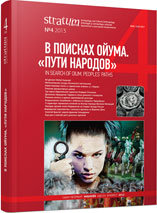Элементы всаднической и дружинной культуры II—III вв. в Поднепровье
Elements of Horsemen’s and Warrior Culture in the Dnieper Region in 2nd—3rd cc. AD
Author(s): Oleg A. RadjushSubject(s): History, Archaeology, Ancient World, Middle Ages, 6th to 12th Centuries
Published by: Издательский дом Stratum, Университет «Высшая антропологическая школа»
Keywords: Dnieper basin; Crimea; Oka basin; Baltic; Roman period; horseback rider's outfi t; hoard; spurs; whip; drinking horn; sinuate enamels
Summary/Abstract: The present article is devoted to recently discovered categories of warriors' enamel goods: spurs, whips and drinking horns. The author fixes the main territories of their distribution in upstream of the Niemen, upstream and middle stream of the Dnieper. Most part of the presented goods belongs to so called stray finds and it makes the purpose of research in chronology and ethnicity more complicated. The present typology of spurs is based on morphological signs. Three variants are singled out. The first (I) variant is characterized by simple bail, the second (II) — by platforms and crosscut bar; the third (III) — by bosses and rossettes on bail. Spurs were mostly bimetallic: their body was made of bronze, and their calk was produced of iron. The chronology of the spurs is based on direct analogies from European Barbaricum. The earliest appear at B2 phase, the peak of their advance is dated to C1, the latest ones continue to exist at C2 and C3 phases.Finds of drinking horns decorated with enamel demonstrate possible existence of warriors' festive culture. Bimetallic whips also made part of the military outfit; they seem to find prototypes in the Roman Empire, where from they spread and further develop in Northern Europe until 11th c. AD.
Journal: Stratum plus. Археология и культурная антропология
- Issue Year: 2013
- Issue No: 4
- Page Range: 51-73
- Page Count: 23
- Language: Russian

